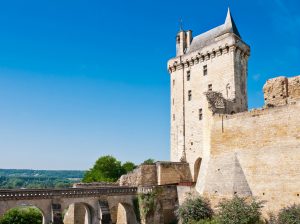Chinon Castle at the heart of French History
A vast and majestic stone construction overlooking the Vienne River and the city that gave it its name, Chinon Castle has been a site occupied for three millennia. From the Gallo-Romans to Joan of Arc, via the Knights Templar, its stones remain silent witnesses to significant episodes in our history. Plunge into a fortress cut into three parts and not to be missed under any circumstances!
A fortress prized over the centuries
Although the rocky promontory supporting the castle reveals traces of a thousand years before our era, it was not until the end of the Gallic period that real signs of construction were evident. This was followed by the constant development of the town of Chinon and the building of a first wall from the time of the Visigoths, which would resist a Roman assault.
The castle itself was gradually built between the 6th and 10th centuries, to become the property of the Counts of Blois, vassals of the King of the Franks. From the year 1044, it was passed on to the Counts of Anjou who conquered Touraine, then to Foulques IV who completed the fortress enclosure. His great-grandson, Henri II Plantagenet, was designated heir to the crown of England in 1153 and made Chinon its continental capital. The castle then took on the shape it has today. Before his death in 1189, Henri II gave birth, notably through his marriage to Eleanor of Aquitaine, to Richard the Lionheart and John the Landless, both future kings. In 1205, Chinon was conquered by the King of France Philippe Auguste. There followed several episodes in which Chinon took part, of alliance and war between the kings of France and England, against a backdrop of crusades and betrayals.
Several notable events still mark the history of the castle, when four dignitaries of the Templar order were imprisoned there in 1308 to prevent Pope Clement V from absolving them. Despite the intervention of three cardinals, King Philip the Fair sent them to the stake.
Also, Joan of Arc appeared in Chinon in 1429, while the court of King Charles VII had been in place there for two years. Two interviews allowed the monarch to use Joan’s divine election to reverse the course of the Hundred Years’ War.
Thereafter, Chinon was more or less abandoned and fell into disrepair. After the Revolution, it was sold to various private individuals who built houses in its various parts. As the site became dangerous, the municipality requested its destruction in 1854 despite its classification as a historical monument in 1840. The intervention of Proposer Mérimée prevented this tragedy, and restoration work began. They are still going on at the beginning of our century.
Outstanding architecture
The main feature of Chinon castle is its separation into three distinct parts, the result of several constructions at different times which were gradually protected by common ramparts. The kings called these areas their “three castles”, which can be seen in the form of three towers on the coat of arms of Chinon. A dry moat separates the three constructions: Fort du Coudray, Château du Milieu and Fort Saint-Georges, each with its own wall. The middle one houses the main dwellings and the Saint-Mélaine priory.
Nine towers overlook the buildings, each of which has its own history. Thus, the Tour du Coudray is the work – modern for the time – of Philippe Auguste. It is the highest of the castle and is equipped with archways, chimneys and latrines. It locks the fort thanks to a double portcullis and a drawbridge. Another remarkable tower, the Clock Tower, is the fortified entrance to the Middle Castle. Erected by Prince John the Landless when he was preparing the fortress for war in 1200, it was modified several times afterwards, notably raised to reach the five levels visible today and to accommodate a bell.
Another remarkable building, Fort Saint-Georges, houses a palace with a purely administrative and housing vocation. Finally, the royal lodgings constitute a wealth built by Duke Louis I of Anjou within the Middle Castle and taking the form of three wings around a courtyard at the time of Charles VII. Only the south wing remains, where there is an auditorium also called the “Salle de la Reconnaissance”.

What to see (and do) today
The royal lodgings, restored since the year 2000, offer the visitor several thematic rooms related to the history of the castle:
a furnished reconstruction of the bedroom of Charles VII;
another of the bedroom of Eleanor of Aquitaine and Henry II, which was originally in the palace of Fort Saint-Georges ;
two rooms bring to life the history of the fortress thanks to 3D reconstructions and objects from excavations;
two other rooms present a collection of art objects retracing the history and perception of Joan of Arc over the centuries;
a more military room displays weapons and details the organisation of King Charles VII’s army;
a last room offers a film retracing the major events in the life of the fortress.
Several other possibilities are offered to you, such as the virtual visit (in augmented reality) of eight reconstructed rooms, to be discovered while walking around with the dedicated tablet called Histopad. For the more playful, two escape games are available, with a background of intrigue linked to the Hundred Years’ War or the Templars.
The visit will also allow you to observe war machines in action or to share a moment with the winegrowers of the Chinon estate.
Standing at the place where Joan of Arc convinced the King of France of her divine mission, where the Knights Templar were tried, where Romans stormed the walls, gives you the feeling of being part of History. Heirs of all these struggles, the peace that now reigns in Chinon encourages through meditation our own inner peace. Now it’s your turn to admire the towers!


